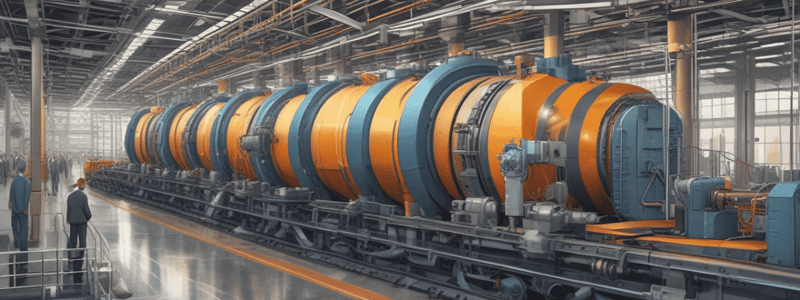Podcast
Questions and Answers
¿Cuál es el objetivo principal de la reducción de residuos en la producción?
¿Cuál es el objetivo principal de la reducción de residuos en la producción?
- Mejorar la satisfacción del cliente
- Reducir costos
- Todas las anteriores (correct)
- Aumentar la eficiencia
¿Cuál es el paso inicial en el análisis de causas raíz?
¿Cuál es el paso inicial en el análisis de causas raíz?
- Analyze and prioritize causes
- Identify possible causes
- Define the problem (correct)
- Gather data
¿Qué herramienta se utiliza para identificar oportunidades de mejora en el proceso de producción?
¿Qué herramienta se utiliza para identificar oportunidades de mejora en el proceso de producción?
- 5 Whys
- Value Stream Mapping (correct)
- SWOT analysis
- Fishbone diagram
¿Cuál es el objetivo principal de la producción justo a tiempo?
¿Cuál es el objetivo principal de la producción justo a tiempo?
¿Cuál es el nombre del método de producción que se utiliza para equilibrar la carga de trabajo en la producción?
¿Cuál es el nombre del método de producción que se utiliza para equilibrar la carga de trabajo en la producción?
¿Cuál es el beneficio de la producción justo a tiempo en cuanto a la reducción de costos?
¿Cuál es el beneficio de la producción justo a tiempo en cuanto a la reducción de costos?
¿Qué sistema de programación de producción utiliza tarjetas o señales para activar la producción y el reabastecimiento?
¿Qué sistema de programación de producción utiliza tarjetas o señales para activar la producción y el reabastecimiento?
¿Cuál es el objetivo principal de Heijunka?
¿Cuál es el objetivo principal de Heijunka?
¿Cuál es la característica principal de un sistema de producción justo a tiempo?
¿Cuál es la característica principal de un sistema de producción justo a tiempo?
¿Cuál es el beneficio de la producción justo a tiempo en cuanto a la flexibilidad?
¿Cuál es el beneficio de la producción justo a tiempo en cuanto a la flexibilidad?
¿Cuál es el nombre del sistema que busca producir y entregar productos justo a tiempo para satisfacer la demanda del cliente?
¿Cuál es el nombre del sistema que busca producir y entregar productos justo a tiempo para satisfacer la demanda del cliente?
Study Notes
Lean Thinking
Waste Reduction
- Identify and eliminate non-value-added activities in the production process
- Types of waste:
- Transportation waste
- Inventory waste
- Motion waste
- Waiting waste
- Overproduction waste
- Overprocessing waste
- Defect waste
- Aim to reduce waste to improve efficiency, reduce costs, and enhance customer satisfaction
Root Cause Analysis
- A method to identify the underlying causes of problems
- Steps:
- Define the problem
- Gather data
- Identify possible causes
- Analyze and prioritize causes
- Implement solutions
- Verify and validate results
- Tools: Fishbone diagram, 5 Whys, SWOT analysis
Value Stream Mapping
- A visual representation of the production process to identify waste and opportunities for improvement
- Steps:
- Identify the value stream
- Map the current state
- Identify waste and opportunities
- Design the future state
- Implement and refine the process
- Symbols and notation:
- Boxes: processes
- Arrows: material flow
- Dotted lines: information flow
- Data boxes: process metrics
Just-in-Time (JIT) Production
- Produce and deliver products just in time to meet customer demand
- Benefits:
- Reduced inventory costs
- Improved quality
- Increased flexibility
- Reduced waste
- Principles:
- Produce only what is needed
- Produce only when needed
- Produce in the correct quantities
Heijunka and Kanban
- Heijunka:
- A production scheduling system to balance production and demand
- Aims to level production volumes and mix to meet customer demand
- Improves efficiency, reduces waste, and enhances customer satisfaction
- Kanban:
- A visual system to manage production and inventory
- Uses cards or signals to trigger production and replenishment
- Aims to maintain a continuous flow of production and minimize inventory
- Pull system: production is driven by customer demand rather than forecasts
Studying That Suits You
Use AI to generate personalized quizzes and flashcards to suit your learning preferences.




